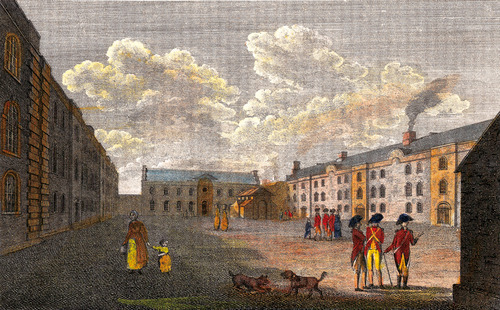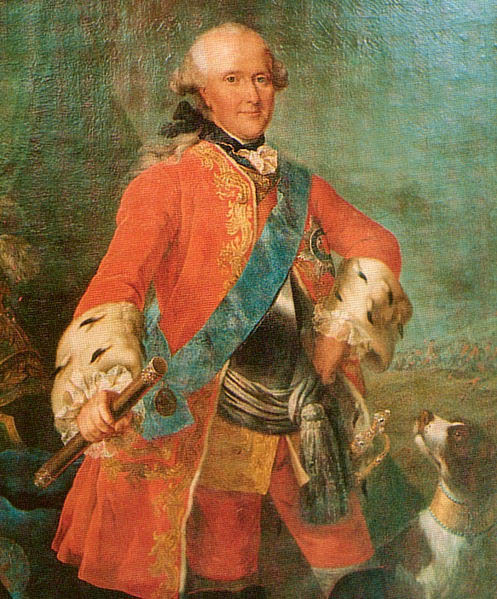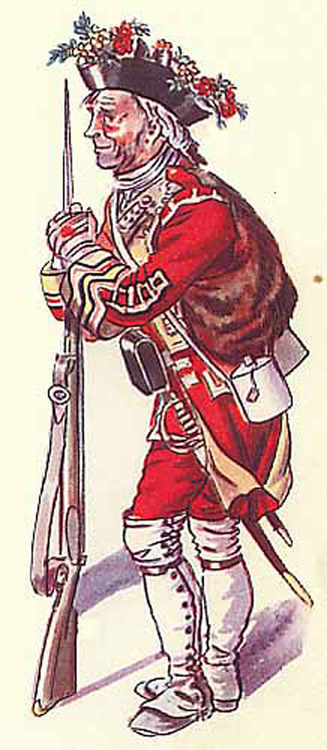The Minden Rose
An important date in the Berwick events diary is 1st August, which this week falls on Thursday. It’s Minden Day, the most important date in the calendar of the Kings Own Scottish Borderers, which since 2004 has been part of the Royal Regiment of Scotland. The regiment was raised in Edinburgh in 1689, and this year marks the 250th anniversary of the regiment being based in Berwick.

Interior of Berwick Barracks
from Fuller’s History of Berwick, 1799.
Many of us will have come out to cheer he regiment as soldiers, past and present, march proudly down the streets. But what is Minden Day and why is it so important.
It commemorates the King’s Own Scottish Borderers’ participation - and arguably most famous victory - in the Battle of Minden on 1st August 1759. This was a decisive victory during the Seven Years War which lasted between 1756 and 1763.

George II, King of Great Britain (1727-60), Duke of Brunswick-Lüneburg and Prince Elector of the Holy Roman Empire.
The background: George II is the King of Great Britain. France and Spain are allies ruled by branches of the Bourbon family. The Seven Years War was fought between between Britain, aided by Prussia, Hanover and Portugal, and France and Spain with Sweden, Russia, Austria and Saxony. It developed into a worldwide war contesting colonial territories throughout the Americas and in Africa, India and as far as the Phillipines.
Minden is a fortified town in north-west Germany on the River Weser. In 1757, the French launched a successful invasion of Hanover. In 1758, Field Marshal Ferdinand, Duke of Brunswick launched a counter-offensive that saw some success. Britain had been keen to avoid sending troops into the conflict on mainland Europe but during the winter of 1758/59 sent reinforcements to Ferdinand.

Ferdinand of Brunswick (1721-92).
The French also sent reinforcements but before they arrived, Ferdinand attempted to push back the French once more. He was defeated at the Batle of Bergen and forced north. The French under Louis, Marquis of Contades settled into a defensive position near the town of Minden.
The British and Hanovarian troops lined up to the north of the French. The Kings Own Scottish Borderers known at the time as the 25th Regiment of Foot were, with other regiments under the command of General Sporcken, ordered to “advance on the beating of drums”. This was misunderstood or incorrectly relayed and the infantry set off before the drums started, towards the French cavalry lines under heavy cannon fire.

The Battle of Minden.
Their push was decisive. Marshal Contades is reputed to have said bitterly after the battle:
“I never thought to see a single line of infantry break through three lines of cavalry ranked in order of battle and tumble them to ruin.”
The British and Hanovarian forces lost a mere 2,800 men compared to the 10,000 plus fatalities suffered by the French that day and this saw the end of the French threat to Hanover that year.
For more about he battle click here.
In Britain, the victory was seen as part of the “Annus Mirabilis” - the year of victories. George II awarded Ferdinand £20,000 and the Order of The Garter.
Today it is commemorated not only by the Kings Own Scottish Borderers, but by the modern equivalents of the Suffolk Regiment, Lancashire Fusiliers, Royal Welch Regiment, Royal Hampshire Regiment, Kings Own Yorkshire Light Infantry and Royal Artillary.
After army reorganisations over the years, their descendants are still known as the Minden Regiments. August 1st is now celebrated as Yorkshire Day.
On 1st August every year, soldiers of the modern regiments mark the day by wearing roses in their caps. This stems from the troops marching through the countryside on their way to Minden and plucking wild roses to place in their tricorn hats.

A British infantryman wearing roses in his tricorn.
Most wear red but the Rifles (Yorkshire Regiment) naturally wear white and the Anglian Regiment (Suffolk Regiment), wear yellow and red. The Royal Welsh commerate the event but do not wear a rose.

Soldiers of the 1st Battalion, Royal Regiment of Scotland march through Berwick. (Photo courtesy KOSB Museum.)

Former soldiers of the Kings Own Scottish Borderers follow. (Photo courtesy KOSB Museum.)
This year will have special significance as the old colours of the Kings Own Scottish Borderers will, after some debate, come home to the Regimental Museum.
Her Royal Highness, the Princess Royal will meet officers and former soldiers in the barracks from about 10.30am where she will hand out Minden roses and oversee the laying up of the colours.
Because of her presence and the extra security, unlike most years, only invited members of the public will be admitted to the Barracks square to watch the ceremony.
So why not join with Princess Anne and cheer the troops parading down Marygate. The parade is expected to leave the Barracks at around 12.30pm on Thursday. Around 650 ex-soldiers are expected to take part - close to three times what there would normally be and pause to remember the events behind it.
And afterwards, why not visit the Kings Own Scottish Borderers regimental museum in Berwick Barracks? The site reopens to the public at 2pm.





